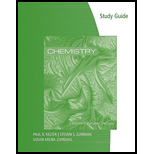
Concept explainers
(a)
Interpretation: The name of the given structures of complex ion is to be stated.
Concept introduction: Rules followed in the naming of coordination compound:
- In naming of coordination compound, the name of anion (ligand) comes first. Metal ion is named second, which is the name of element.
- An ‘o’ is added to the root name of anion.
- Greek prefix is used to express the number of ligands.
- Roman numeral is used to denote the oxidation state of metal ion.
- In case of more than one type of ligand present in a compound, they are named alphabetically.
- The suffix ‘-ate’ is added to metal ion if complex ion contains negative charge. Latin names are also used to identify the name of metals.
To determine: The name of the given structure of complex ion.
(b)
Interpretation: The name of the given structures of complex ion is to be stated.
Concept introduction: Rules followed in the naming of coordination compound:
- In naming of coordination compound, the name of anion (ligand) comes first. Metal ion is named second, which is the name of element.
- An ‘o’ is added to the root name of anion.
- Greek prefix is used to express the number of ligands.
- Roman numeral is used to denote the oxidation state of metal ion.
- In case of more than one type of ligand present in a compound, they are named alphabetically.
- The suffix ‘-ate’ is added to metal ion if complex ion contains negative charge. Latin names are also used to identify the name of metals.
To determine: The name of the given structure of complex ion.
(c)
Interpretation: The name of the given structures of complex ion is to be stated.
Concept introduction: Rules followed in the naming of coordination compound:
- In naming of coordination compound, the name of anion (ligand) comes first. Metal ion is named second, which is the name of element.
- An ‘o’ is added to the root name of anion.
- Greek prefix is used to express the number of ligands.
- Roman numeral is used to denote the oxidation state of metal ion.
- In case of more than one type of ligand present in a compound, they are named alphabetically.
- The suffix ‘-ate’ is added to metal ion if complex ion contains negative charge. Latin names are also used to identify the name of metals.
To determine: The name of the given structure of complex ion.
The name of complex ion
Trending nowThis is a popular solution!

Chapter 21 Solutions
Study Guide for Zumdahl/Zumdahl/DeCoste’s Chemistry, 10th Edition
- Identify and provide an explanation that distinguishes a qualitative and quantitative chemical analysis. Provide examples.arrow_forwardIdentify and provide an explanation of the operational principles behind a Atomic Absorption Spectrometer (AAS). List the steps involved.arrow_forwardInstructions: Complete the questions in the space provided. Show all your work 1. You are trying to determine the rate law expression for a reaction that you are completing at 25°C. You measure the initial reaction rate and the starting concentrations of the reactions for 4 trials. BrO³¯ (aq) + 5Br¯ (aq) + 6H* (aq) → 3Br₂ (l) + 3H2O (l) Initial rate Trial [BrO3] [H*] [Br] (mol/L) (mol/L) | (mol/L) (mol/L.s) 1 0.10 0.10 0.10 8.0 2 0.20 0.10 0.10 16 3 0.10 0.20 0.10 16 4 0.10 0.10 0.20 32 a. Based on the above data what is the rate law expression? b. Solve for the value of k (make sure to include proper units) 2. The proposed reaction mechanism is as follows: i. ii. BrО¸¯ (aq) + H+ (aq) → HBrO3 (aq) HBrO³ (aq) + H* (aq) → H₂BrO3* (aq) iii. H₂BrO³* (aq) + Br¯ (aq) → Br₂O₂ (aq) + H2O (l) [Fast] [Medium] [Slow] iv. Br₂O₂ (aq) + 4H*(aq) + 4Br(aq) → 3Br₂ (l) + H2O (l) [Fast] Evaluate the validity of this proposed reaction. Justify your answer.arrow_forward
- a. H3C CH3 H, 1.0 equiv. Br2arrow_forwardH3C. H3C CH 3 CH 3 CH3 1. LDA 2. PhSeCl 3. H2O2arrow_forwardPlease predict the products for each of the following reactions: 1.03 2. H₂O NaNH, 1. n-BuLi 2. Mel A H₂ 10 9 0 H2SO4, H₂O HgSO4 Pd or Pt (catalyst) B 9 2 n-BuLi ♡ D2 (deuterium) Lindlar's Catalyst 1. NaNH2 2. EtBr Na, ND3 (deuterium) 2. H₂O2, NaOH 1. (Sia)2BH с Darrow_forward
- in the scope of ontario SCH4U grade 12 course, please show ALL workarrow_forwardIs the chemical reaction CuCl42-(green) + 4H2O <==> Cu(H2O)42+(blue) + 4Cl- exothermic or endothermic?arrow_forwardIf we react tetraethoxypropane with hydrazine, what is the product obtained (explain its formula). State the reason why the corresponding dialdehyde is not used.arrow_forward
 Chemical Principles in the LaboratoryChemistryISBN:9781305264434Author:Emil Slowinski, Wayne C. Wolsey, Robert RossiPublisher:Brooks Cole
Chemical Principles in the LaboratoryChemistryISBN:9781305264434Author:Emil Slowinski, Wayne C. Wolsey, Robert RossiPublisher:Brooks Cole Chemistry: The Molecular ScienceChemistryISBN:9781285199047Author:John W. Moore, Conrad L. StanitskiPublisher:Cengage Learning
Chemistry: The Molecular ScienceChemistryISBN:9781285199047Author:John W. Moore, Conrad L. StanitskiPublisher:Cengage Learning Chemistry & Chemical ReactivityChemistryISBN:9781337399074Author:John C. Kotz, Paul M. Treichel, John Townsend, David TreichelPublisher:Cengage Learning
Chemistry & Chemical ReactivityChemistryISBN:9781337399074Author:John C. Kotz, Paul M. Treichel, John Townsend, David TreichelPublisher:Cengage Learning Chemistry & Chemical ReactivityChemistryISBN:9781133949640Author:John C. Kotz, Paul M. Treichel, John Townsend, David TreichelPublisher:Cengage LearningChemistry: Matter and ChangeChemistryISBN:9780078746376Author:Dinah Zike, Laurel Dingrando, Nicholas Hainen, Cheryl WistromPublisher:Glencoe/McGraw-Hill School Pub Co
Chemistry & Chemical ReactivityChemistryISBN:9781133949640Author:John C. Kotz, Paul M. Treichel, John Townsend, David TreichelPublisher:Cengage LearningChemistry: Matter and ChangeChemistryISBN:9780078746376Author:Dinah Zike, Laurel Dingrando, Nicholas Hainen, Cheryl WistromPublisher:Glencoe/McGraw-Hill School Pub Co





